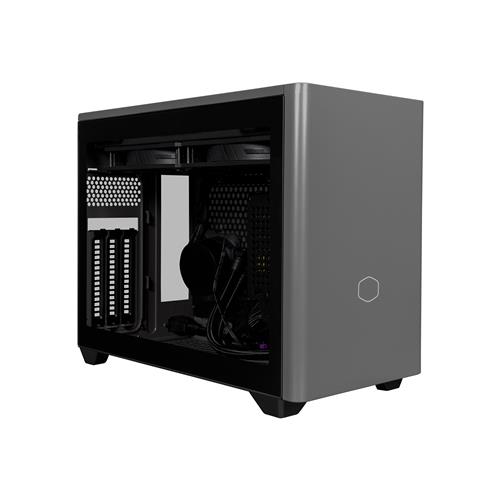Introduction

It’s finally here! The hotly anticipated Core Ultra 9 285K Arrow Lake-S desktop processor is in our hands, and we can’t wait to tell you all about it. The 285K is the flagship processor model from this generation, and logically succeeds the Core i9-14900K. It has all the cores this silicon has to offer—8P+16E, with all the on-chip technologies. It’s also fully unlocked and ready for you to take it on an overclocking adventure. The Arrow Lake architecture denotes many firsts for Intel in the desktop market. Notably, this is the company’s first desktop processor with a chiplet-based disaggregated design. The mobile segment got it with the Core Ultra Meteor Lake, and Intel has been making chiplet based Xeon Scalable server processors for a few years now. Intel is pricing the Core Ultra 9 285K at $589. Given its core-count and pricing, its apparent rivals from the AMD camp are the Ryzen 9 9950X Zen 5, and the Ryzen 9 7950X3D Zen 4.
The Core Ultra 9 285K comes with a maxed out 8P+16E core-configuration. Intel has updated both core types with Arrow Lake. These amount to eight Lion Cove P-cores, with a nominal generational IPC increase, and 16 of the swanky new Skymont E-cores. Skymont was the star of the show with Lunar Lake, as Intel achieved a nearly 50% IPC leap over the Crestmont low-power island E-cores powering the previous generation Meteor Lake. With Arrow Lake, these Skymont cores achieve a 32% IPC jump over the Gracemont E-cores from Raptor Lake. Besides the increased IPC, these E-cores even run at higher clock speeds than Gracemont, which means multithreaded productivity workloads are in for a treat. The 285K is technically a 24-core/24-thread processor. The Lion Cove P-cores ditch SMT. So any gen-on-gen multithreaded performance improvements over the i9-14900K rest squarely on stronger cores and new technology, despite a decrease in total thread count.

We’ve extensively detailed the Arrow Lake microarchitecture in our architecture preview article, which went live a couple of weeks ago. As we mentioned, this is Intel’s first desktop processor that’s based on chiplets. The guiding philosophy is that rather than building one large monolithic silicon on the latest foundry node (expensive, compounded by lower yields per wafer), Intel identifies specific IP blocks that benefit the most from a switch to the latest foundry node—in this case, the CPU complex—and build a chiplet with it that’s smaller (higher yields per wafer thanks to smaller dies). The Compute tile houses the CPU cores, and is built on the TSMC N3B (3 nm) node, which is more advanced than the TSMC N4P (4 nm) node that AMD builds its Zen 5 CCDs on. With this, Intel is taking back foundry technology leadership from AMD after a long span of five years. The iGPU is built on a separate chiplet that uses the still fairly advanced 5 nm TSMC N5 node, while the rest of the processor with the various I/O controllers, and an integrated NPU, are built on TSMC 6 nm—same node as the cIOD on Ryzens.
This is Intel’s first desktop processor with an NPU, but it isn’t the latest NPU 4 from Intel that you find on Core Ultra 200V Lunar Lake mobile processors, but rather the older NPU 3 unit from Core Ultra 100 series Meteor Lake, which can only do 13 TOPS. It hence misses out on Microsoft Copilot+ native acceleration, but don’t fret—there’s still a lot you can do with 13 TOPS, Windows 11 can put the NPU to good use in its many in-built apps and utilities, and so can Microsoft Teams. Intel has given Arrow Lake-S a fairly powerful iGPU based on the Xe-LPG graphics architecture, and an updated media engine that can accelerate AV1 and HEVC encoding. There are a few changes to the I/O. For starters, DDR4 support is removed, as the memory controllers are re-engineered. The number of PCIe Gen 5 lanes from the CPU are increased to 20, so you can use a Gen 5 NVMe SSD without subtracting PCIe lanes from the x16 PEG slot. There’s also integrated Thunderbolt 4.
Each of the eight Lion Cove P-cores on the 285K comes with a 3.70 GHz base frequency, and the P-cores boost up to 5.70 GHz. The classic Turbo Boost algorithm boosts P-cores up to 5.50 GHz. Turbo Boost Max 3.0 pushes a couple of cores up a notch to 5.60 GHz, and from there, provided your cooling solution is up to the task, Thermal Velocity Boost enables 5.70 GHz. The 16 E-cores, divided into four clusters, tick at 3.20 GHz with an impressive 4.60 GHz boost frequency. Each P-core comes with a dedicated 3 MB L2 cache, while each E-core cluster shares a 4 MB L2 cache among four E-cores. The P-cores and E-core clusters share a 36 MB L3 cache.
| Price | Cores / Threads | Base Clock | Max. Boost | L3 Cache | TDP | Architecture | Process | Socket | |
|---|---|---|---|---|---|---|---|---|---|
| Intel Core i5 | |||||||||
| Core i5-12400F | $110 | 6 / 12 | 2.5 GHz | 4.4 GHz | 18 MB | 65 W | Alder Lake | 10 nm | LGA 1700 |
| Core i5-13400F | $170 | 6+4 / 16 | 2.5 / 1.8 GHz | 4.6 / 3.3 GHz | 20 MB | 65 W | Raptor Lake | 10 nm | LGA 1700 |
| Core i5-12600K | $170 | 6+4 / 16 | 3.7 / 2.8 GHz | 4.9 / 3.6 GHz | 20 MB | 125 W | Alder Lake | 10 nm | LGA 1700 |
| Core i5-13600K | $225 | 6+8 / 20 | 3.5 / 2.6 GHz | 5.1 / 3.9 GHz | 24 MB | 125 W | Raptor Lake | 10 nm | LGA 1700 |
| Core i5-14600K | $260 | 6+8 / 20 | 3.5 / 2.6 GHz | 5.3 / 4.0 GHz | 24 MB | 125 W | Raptor Lake | 10 nm | LGA 1700 |
| Intel Core Ultra 5 | |||||||||
| Core Ultra 5 245K | $310 | 6+8 / 14 | 4.2 / 3.6 GHz | 5.2 / 4.6 GHz | 24 MB | 159 W | Arrow Lake | 3 nm | LGA 1851 |
| AMD Ryzen 5 | |||||||||
| Ryzen 5 8500G | $150 | 6 / 12 | 3.5 GHz | 5.0 GHz | 16 MB | 65 W | Phoenix 2 | 4 nm | AM5 |
| Ryzen 5 5600X | $135 | 6 / 12 | 3.7 GHz | 4.6 GHz | 32 MB | 65 W | Zen 3 | 7 nm | AM4 |
| Ryzen 5 7600 | $185 | 6 / 12 | 3.8 GHz | 5.1 GHz | 32 MB | 65 W | Zen 4 | 5 nm | AM5 |
| Ryzen 5 7600X | $210 | 6 / 12 | 4.7 GHz | 5.3 GHz | 32 MB | 105 W | Zen 4 | 5 nm | AM5 |
| Ryzen 5 9600X | $250 | 6 / 12 | 3.9 GHz | 5.4 GHz | 32 MB | 65 W | Zen 5 | 4 nm | AM5 |
| Intel Core i7 | |||||||||
| Core i7-12700K | $210 | 8+4 / 20 | 3.6 / 2.7 GHz | 5.0 / 3.8 GHz | 25 MB | 125 W | Alder Lake | 10 nm | LGA 1700 |
| Core i7-13700K | $280 | 8+8 / 24 | 3.4 / 2.5 GHz | 5.4 / 4.2 GHz | 30 MB | 125 W | Raptor Lake | 10 nm | LGA 1700 |
| Core i7-14700K | $355 | 8+12 / 28 | 3.4 / 2.5 GHz | 5.6 / 4.3 GHz | 33 MB | 125 W | Raptor Lake | 10 nm | LGA 1700 |
| Intel Core Ultra 7 | |||||||||
| Core Ultra 7 265K | $395 | 8+12 / 20 | 3.9 / 3.3 GHz | 5.5 / 4.6 GHz | 30 MB | 250 W | Arrow Lake | 3 nm | LGA 1851 |
| AMD Ryzen 7 | |||||||||
| Ryzen 7 5700G | $165 | 8 / 16 | 3.8 GHz | 4.6 GHz | 16 MB | 65 W | Zen 3 + Vega | 7 nm | AM4 |
| Ryzen 7 5700X | $160 | 8 / 16 | 3.4 GHz | 4.6 GHz | 32 MB | 65 W | Zen 3 | 7 nm | AM4 |
| Ryzen 7 7700 | $280 | 8 / 16 | 3.8 GHz | 5.3 GHz | 32 MB | 65 W | Zen 4 | 5 nm | AM5 |
| Ryzen 7 7700X | $275 | 8 / 16 | 4.5 GHz | 5.4 GHz | 32 MB | 105 W | Zen 4 | 5 nm | AM5 |
| Ryzen 7 9700X | $330 | 8 / 16 | 3.8 GHz | 5.5 GHz | 32 MB | 65 W | Zen 5 | 4 nm | AM5 |
| Ryzen 7 5800X | $165 | 8 / 16 | 3.8 GHz | 4.7 GHz | 32 MB | 105 W | Zen 3 | 7 nm | AM4 |
| Ryzen 7 5800X3D | $340 | 8 / 16 | 3.4 GHz | 4.5 GHz | 96 MB | 105 W | Zen 3 | 7 nm | AM4 |
| Ryzen 7 7800X3D | $370 | 8 / 16 | 4.2 GHz | 5.0 GHz | 96 MB | 120 W | Zen 4 | 5 nm | AM5 |
| Intel Core i9 | |||||||||
| Core i9-12900K | $280 | 8+8 / 24 | 3.2 / 2.4 GHz | 5.2 / 3.9 GHz | 30 MB | 125 W | Alder Lake | 10 nm | LGA 1700 |
| Core i9-13900K | $415 | 8+16 / 32 | 3.0 / 2.2 GHz | 5.8 / 4.3 GHz | 36 MB | 125 W | Raptor Lake | 10 nm | LGA 1700 |
| Core i9-14900K | $445 | 8+16 / 32 | 3.2 / 2.4 GHz | 6.0 / 4.4 GHz | 36 MB | 125 W | Raptor Lake | 10 nm | LGA 1700 |
| Intel Core Ultra 9 | |||||||||
| Core Ultra 9 285K | $590 | 8+16 / 24 | 3.7 / 3.2 GHz | 5.7 / 4.6 GHz | 36 MB | 250 W | Arrow Lake | 3 nm | LGA 1851 |
| AMD Ryzen 9 | |||||||||
| Ryzen 9 5900X | $265 | 12 / 24 | 3.7 GHz | 4.8 GHz | 64 MB | 105 W | Zen 3 | 7 nm | AM4 |
| Ryzen 9 7900 | $370 | 12 / 24 | 3.7 GHz | 5.4 GHz | 64 MB | 65 W | Zen 4 | 5 nm | AM5 |
| Ryzen 9 7900X | $400 | 12 / 24 | 4.7 GHz | 5.6 GHz | 64 MB | 170 W | Zen 4 | 5 nm | AM5 |
| Ryzen 9 7900X3D | $580 | 12 / 24 | 4.4 GHz | 5.6 GHz | 128 MB | 120 W | Zen 4 | 5 nm | AM5 |
| Ryzen 9 9900X | $430 | 12 / 24 | 4.4 GHz | 5.6 GHz | 64 MB | 120 W | Zen 5 | 4 nm | AM5 |
| Ryzen 9 5950X | $345 | 16 / 32 | 3.4 GHz | 4.9 GHz | 64 MB | 105 W | Zen 3 | 7 nm | AM4 |
| Ryzen 9 7950X | $510 | 16 / 32 | 4.5 GHz | 5.7 GHz | 64 MB | 170 W | Zen 4 | 5 nm | AM5 |
| Ryzen 9 7950X3D | $550 | 16 / 32 | 4.2 GHz | 5.7 GHz | 128 MB | 120 W | Zen 4 | 5 nm | AM5 |
| Ryzen 9 9950X | $600 | 16 / 32 | 4.3 GHz | 5.7 GHz | 64 MB | 170 W | Zen 5 | 4 nm | AM5 |







